PRICE INDEXES AND CONTRACT PRICE INDEXATION
NOTES
INQUIRIES
For further information about these and related statistics, contact the National Information and Referral Service on 1300 135 070.
SUMMARY COMMENTARY
OVERVIEW OF THE INDEXES
This article updates the annual analytical living cost indexes for selected Australian households with data to June quarter 2007. Prior to June quarter 2006, these indexes were published annually in the Australian Economic Indicators, cat. no. 1350.0. The indexes now cover the period from June quarter 1998 up to and including the June quarter 2007.
These price indexes are designed to measure the impact of changes in prices on the out-of-pocket living costs experienced by four types of Australian households. The four household types for which these indexes have been constructed are:
- Employee households
- Age pensioner households
- Other government transfer recipient households
- Self-funded retiree households.
Households have been categorised to these groups based on principal source of household income, derived from the 2003-04 Household Expenditure Survey (HES). These household groups account for just over 90% of Australian households.
The indexes represent the conceptually preferred measures for assessing the impact of changes in prices on the disposable incomes of households. In other words, these indexes are particularly suited for assessing whether the disposable incomes of households have kept pace with price changes. The Australian Consumer Price Index (CPI), on the other hand, is designed to measure price inflation for the household sector as a whole and, as such, is not the conceptually ideal measure for assessing the impact of price changes on the disposable incomes of households.
The main difference compared to the CPI is that the living cost indexes include mortgage interest (on the purchase of both houses and the underlying land) and consumer credit charges but do not include house purchases. Insurance (other than health insurance) is also treated differently in the living cost indexes. The weight for insurance in the CPI relates to the net value of the service provided by the insurance company (in simple terms, the amount of premiums paid by households less the amounts reimbursed by way of claims). In the living cost indexes, the weight relates to the gross value of insurance premiums paid by households.
A further difference is that the regional weights for the CPI are based on the HES distributions in the capital cities, whereas the weights in the analytical living cost indexes are based on the HES distributions for the State or Territory. This produces more reliable weights for some of the smaller expenditure categories in the analytical series.
With the exception of interest charges, all price measurements used in the analytical living cost indexes are taken from the CPI. CPI price movements for lower level commodity categories are applied to the expenditure patterns of the four household types. Not all CPI items are used in each of the indexes. For example only concession prices are selected for some health items for Age pensioner and Other government transfer recipient households.
EXPENDITURE PATTERNS OF THE SELECTED HOUSEHOLD TYPES
Calculation of the aggregate impact of price changes on each of the household types involves weighting together the price movements recorded for individual goods and services. For each household type, the weight assigned to any particular good or service reflects the proportion of total household expenditure accounted for by expenditure on the item.
Table 1 shows average weekly expenditure per household during 2003-04 for each of the four household types, at June quarter 2005 prices. The commodity grouping used corresponds to the commodity groups used for the current (15th series) CPI.
Table 1 illustrates significant differences in expenditures, both in total and at the individual commodity group level across the household types. Although differences in incomes are likely to be a major reason for this, other factors such as the demographic make-up of the households and dwelling tenure would also play a part. For example, Age pensioner households have on average the lowest number of persons per household and self-funded retiree households have a higher than average rate of outright home ownership.
Table 2 presents the same data in percentage terms. It is this data that produces the expenditure shares or weights that are given to each household type, and to which the price movements are applied.
Table 1: Estimated Average Weekly Expenditure in 2003-04, Commodity group and household types(a)(b) |
|  |
 | Household type |  |
| Commodity group | Employee | Age
pensioner | Other government
transfer recipient | Self-funded
retiree |  |
Average weekly expenditure per household ($) |  |
|  |
| Food | 183 | 89 | 105 | 130 |  |
| Alcohol and tobacco | 89 | 30 | 55 | 59 |  |
| Clothing and footwear | 48 | 21 | 27 | 31 |  |
| Housing(c) | 128 | 71 | 106 | 83 |  |
| Household contents and services | 113 | 48 | 58 | 97 |  |
| Health | 53 | 31 | 18 | 68 |  |
| Transportation | 165 | 48 | 60 | 114 |  |
| Communication | 40 | 16 | 25 | 24 |  |
| Recreation | 142 | 48 | 56 | 130 |  |
| Education | 33 | 1 | 10 | 5 |  |
| Financial and insurance services(d) | 124 | 20 | 33 | 36 |  |
| Total | 1 119 | 421 | 553 | 777 |  |
|  |
|  |
| No of Households ('000) | 4 463 | 1 017 | 1 065 | 468 |  |
| Persons/household (no) | 2.86 | 1.57 | 2.40 | 1.68 |  |
|  |
| (a) Based on 2003-04 Household Expenditure Survey (HES) at June quarter 2005 prices. |
| (b) Figures may not add up due to rounding. |
| (c) House purchase are included in the CPI but excluded from the population subgroup indexes. |
| (d) Includes interest charges and general insurance. Interest charges are excluded from the CPI and general insurance is calculated on a different basis. |
Table 2: Expenditure Weights, By Major Commodity group and household type(a)(b) |
|  |
 | Household type |  |
| Commodity group | Employee | Age
pensioner | Other government
transfer recipient | Self-funded
retiree |  |
Average of Total Expenditure (%) |  |
|  |
| Food | 16.38 | 21.06 | 18.96 | 16.78 |  |
| Alcohol and tobacco | 7.94 | 7.16 | 10.01 | 7.56 |  |
| Clothing and footwear | 4.33 | 5.09 | 4.83 | 3.99 |  |
| Housing(c) | 11.45 | 16.81 | 19.22 | 10.64 |  |
| Household contents and services | 10.12 | 11.28 | 10.45 | 12.55 |  |
| Health | 4.74 | 7.32 | 3.20 | 8.72 |  |
| Transportation | 14.70 | 11.40 | 10.92 | 14.67 |  |
| Communication | 3.60 | 3.75 | 4.47 | 3.03 |  |
| Recreation | 12.71 | 11.27 | 10.15 | 16.79 |  |
| Education | 2.94 | 0.15 | 1.84 | 0.64 |  |
| Financial and insurance services(d) | 11.08 | 4.71 | 5.95 | 4.63 |  |
| Total | 100.00 | 100.00 | 100.00 | 100.00 |  |
|  |
| (a) Based on 2003-04 Household Expenditure Survey (HES) at June quarter 2005 prices. |
| (b) Figures may not add up due to rounding. |
| (c) House purchases are included in the CPI but excluded from the population subgroup indexes. |
| (d) Includes interest charges and general insurance. Interest charges are excluded from the CPI and general insurance is calculated on a different basis. |
There are some notable differences in the expenditure weights across the household types. For example, the proportion of expenditure allocated to Food is highest for Age pensioner households. It is also relatively high for Other government transfer recipient households. Employee households allocate a higher proportion of their expenditures to Transportation, Education and Financial and insurance services (which includes interest charges) than the other household types. Other government transfer recipients allocate higher proportions of their expenditures to Housing, Alcohol and tobacco and Communication. Self-funded retiree households have higher relative expenditures on Household contents and services and Recreation than the other household types. Health costs account for a significantly higher proportion of expenditure of Age pensioner and Self-funded retiree households.
RESULTS
OVERVIEW
Over the four quarters from June 2006 to June 2007, changes in living costs ranged from a low of 1.9% (Self-funded retiree households) to a high of 3.1% (Employee households). The CPI rose by 2.1% over the same period. Over the nine year period covered by the indexes, changes in living costs for each household type has tracked quite closely to the CPI. Self-funded retirees experienced an increase of 29.3%, slightly lower than the 30.2% increase in the CPI. The living costs of Employee households showed the highest increase of 32.6%, Other government transfer recipient households by 32.3% and Age pensioner households by 32.0%.
The index series for the various household types from June quarter 1998 to June quarter 2007 are shown in Charts 1 to 4 and quarterly percentage changes in the indexes in Charts 5 to 8. The data on which the charts are based are provided in Appendix 1.
Graph 1: Index Numbers for Employee households, June quarter 1998 = 100.0
 Graph 2: Index Numbers for Age Pensioner Households,
Graph 2: Index Numbers for Age Pensioner Households, June quarter 1998 = 100.0
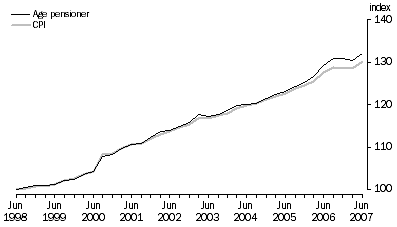 Graph 3: Index Numbers for Other Government transfer Recipient Households,
Graph 3: Index Numbers for Other Government transfer Recipient Households, June quarter 1998 = 100.0
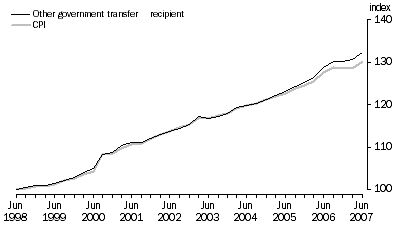 Graph 4: Index Numbers for Self-Funded Retiree Households,
Graph 4: Index Numbers for Self-Funded Retiree Households, June quarter 1998 = 100.0
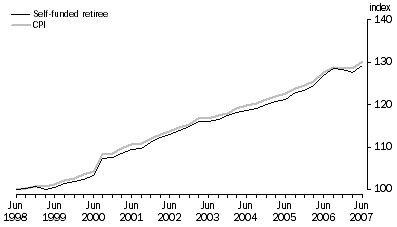 Graph 5: Employee Households,
Graph 5: Employee Households, Percentage change (from previous quarter)
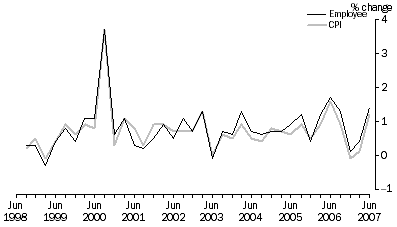 Graph 6: Age Pensioner Households,
Graph 6: Age Pensioner Households, Percentage change (from previous quarter)
 Graph 7: Other Government Recipient Households,
Graph 7: Other Government Recipient Households, Percentage change (from previous quarter)
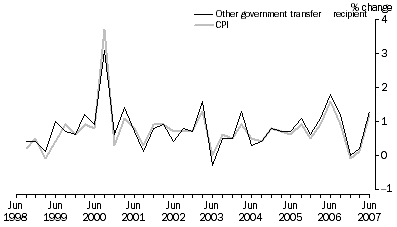 Graph 8: Self-Funded Retiree Households,
Graph 8: Self-Funded Retiree Households, Percentage change (from previous quarter)
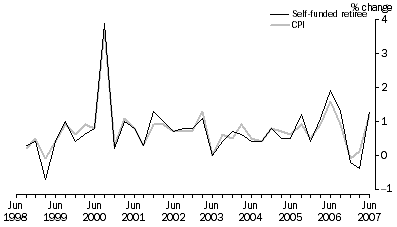
Changes over the last 12 months in the price indexes at the equivalent of the CPI commodity group level are presented in Table 3. Differences in the price experiences of household types at the group level reflect differences in expenditure weights at the lower levels and different treatments of housing, interest charges and insurance compared to the CPI.
Table 3: Change in living cost indexes, by commodity group June quarter 2006 to June quarter 2007 |
|  |
 | Household type |  |
| Commodity group | Employee | Age
pensioner | Other government
transfer recipient | Self-funded
retiree | CPI |  |
Percentage Change |  |
|  |
| Food | 2.4 | 1.4 | 2.2 | 1.3 | 2.2 |  |
| Alcohol and tobacco | 3.2 | 3.1 | 3.5 | 2.7 | 3.0 |  |
| Clothing and footwear | 0.8 | 0.7 | 0.8 | 0.8 | 0.7 |  |
| Housing(a) | 4.1 | 4.1 | 4.6 | 3.3 | 3.6 |  |
| Household contents and services | 2.1 | 1.4 | 1.6 | 1.4 | 2.1 |  |
| Health | 4.2 | 3.7 | 3.4 | 4.2 | 4.1 |  |
| Transportation | 0.0 | -0.3 | -0.5 | -0.2 | 0.2 |  |
| Communication | 1.5 | 7.4 | 5.9 | 3.1 | 1.5 |  |
| Recreation | 0.8 | 1.3 | 0.7 | 1.5 | 1.0 |  |
| Education | 4.5 | 3.7 | 3.9 | 5.9 | 4.3 |  |
| Financial and insurance services(b) | 11.4 | 3.4 | 8.4 | 4.4 | 1.5 |  |
| Total | 3.1 | 2.2 | 2.8 | 1.9 | 2.1 |  |
|  |
| (a) House purchases are included in the CPI but excluded from the population subgroup indexes. |
| (b) Includes interest charges and general insurance. Interest charges are excluded from the CPI and general insurance is calculated on a different basis. |
The index points contribution to the totals are presented in Table 4.
The change in a component item's points contribution from one period to the next provides a direct measure of the contribution to the change in the All groups index resulting from the change in that component's price. Points contribution and points contribution change can be useful when analysing the relative impact of price change of various commodity groups on total price change.
Table 4: Contributions to total index numbers by Commodity group, June quarter 2006 to June quarter 2007 |
|  |
 | Employee | Age pensioner | Other government transfer recipient | Self-funded retiree |  |
| Commodity group | Jun qtr 2007 | Jun qtr 2006 | Jun qtr 2007 | Jun qtr 2006 | Jun qtr 2007 | Jun qtr 2006 | Jun qtr 2007 | Jun qtr 2006 |  |
|  |
| Food | 22.26 | 21.75 | 28.91 | 28.51 | 25.89 | 25.34 | 22.71 | 22.42 |  |
| Alcohol and tobacco | 10.46 | 10.13 | 9.39 | 9.11 | 13.23 | 12.78 | 9.75 | 9.50 |  |
| Clothing and footwear | 5.28 | 5.24 | 6.20 | 6.16 | 5.88 | 5.83 | 4.81 | 4.78 |  |
| Housing(a) | 15.20 | 14.59 | 22.44 | 21.56 | 25.76 | 24.62 | 13.86 | 13.42 |  |
| Household contents and services | 12.90 | 12.63 | 14.19 | 13.99 | 13.19 | 12.97 | 15.59 | 15.37 |  |
| Health | 6.35 | 6.10 | 9.78 | 9.44 | 4.27 | 4.13 | 11.56 | 11.10 |  |
| Transportation | 19.54 | 19.54 | 15.32 | 15.37 | 14.80 | 14.87 | 19.24 | 19.28 |  |
| Communication | 4.48 | 4.41 | 4.89 | 4.56 | 5.75 | 5.43 | 3.77 | 3.66 |  |
| Recreation | 15.99 | 15.87 | 14.32 | 14.13 | 12.70 | 12.62 | 21.19 | 20.88 |  |
| Education | 3.99 | 3.82 | 0.21 | 0.20 | 2.48 | 2.38 | 0.87 | 0.83 |  |
| Financial and insurance services(b) | 16.15 | 14.50 | 6.36 | 6.15 | 8.35 | 7.70 | 5.94 | 5.68 |  |
| Total | 132.6 | 128.6 | 132.0 | 129.2 | 132.3 | 128.7 | 129.3 | 126.9 |  |
|  |
| (a) House purchases are included in the CPI but excluded from the population subgroup indexes. |
| (b) Includes interest charges and general insurance. Interest charges are excluded from the CPI and general insurance is calculated on a different basis. |
RESULTS FOR COMMODITY GROUP BY HOUSEHOLD TYPE
The most significant contributors to the annual percentage change for each household type were:
- Financial and insurance services for Employee households
- Housing for Age pensioner households
- Housing for Other government transfer recipient households
- Health for Self-funded retiree households
The lower increase in the Food index for Age pensioners and Self-funded retiree households reflects their higher relative expenditure on fruit. Fruit fell 18% in the year to June 2007, driven by the fall in banana prices from the high levels experienced after Cyclone Larry.
The higher increase in the Alcohol and Tobacco index for Other government transfer recipients is due to their higher relative expenditure on tobacco, which increased 3.7% through the year. Self-funded retirees had a lower increase than the CPI due to their relatively lower expenditure on tobacco, and relatively higher expenditure on wine which had an offsetting effect due to a small fall in wine prices through the year of -1.0%.
The Clothing and footwear index closely matches the CPI for all household types.
There is a conceptual difference in these series compared to the CPI in that House purchase is not included (see the explanatory notes for more information). House purchase increased by 2.7% in the CPI. Property rates and charges which have higher relative expenditure within the housing group analytical series compared to the CPI, rose by 5.6%. House repairs and maintenance, which rose by 1.4%, also has a higher relative expenditure in the analytical series compared to the CPI, especially for Self Funded retirees. The higher increase in the Housing index for Employees, Age pensioners and Other government transfer recipients is partially due to their higher relative expenditure on rents, which increased 5.2% through the year. The lower result for Self-funded retiree households is due to a lower relative expenditure on rents along with a higher relative expenditure on House repairs and maintenance.
Differences across the selected households groups for Household contents and services can be largely explained by the 'net' child care index, which increased 12.8% in the CPI through the year to June quarter 2007. Employee households have a relatively higher expenditure on child care. There is relatively less expenditure by Other government transfer recipient households and child care is not included for Age pensioner and Self-funded retiree households. Self-funded retiree households also have a higher relative expenditure on Major household appliances and a lower relative expenditure on Furniture which both had offsetting effects.
The smaller increases in Health for Age pensioners, and Other government transfer recipients is due to their higher relative expenditure on Pharmaceuticals which is a 'net' cost, which includes the impact of the Pharmaceutical Benefits Scheme (PBS) subsidies.
The decreases in Transportation for Age pensioner, Other government transfer recipient and Self-funded retiree households reflect their higher relative expenditure on automotive fuel which decreased -4.2% through the year.
The higher increases in Communication for Age pensioners, Other government transfer recipients and Self-funded retirees is due to their higher relative expenditure on fixed phone concession services.
The higher increase in the Recreation index for Self-funded retirees is due to a combination of their higher relative expenditure on Holiday travel and accommodation and their lower relative expenditure on Audio, visual and computing.
Expenditures on Education for Age pensioner and Self-funded retiree households is minimal. The smaller increases in Education for Other government transfer recipient households is due to their lower relative expenditure on preschool and primary education which increased by 8.3% through the year, and their higher relative expenditure on tertiary education which increased at a lower rate of 0.3% through the year.
Financial and insurance services were significant contributors for Employees and Other government transfer recipients. This is attributable to the combined impact of increases in debt and higher interest rates. There is a conceptual difference in these series compared to the CPI. The living cost indexes include mortgage interest and consumer credit charges but exclude all other financial services. They also do not include house purchases. The insurance weight in the living cost indexes relates to the gross value of insurance premiums paid by households, while in the CPI the weight relates to the amount of premiums paid by households less the amounts reimbursed by way of claims.
CONCLUSIONS
These analytical indexes have been designed to answer the question:
‘By how much would after tax money incomes need to change to allow households to purchase the same quantity of consumer goods and services that they purchased in the base period?’
In the long term changes in living costs have been broadly similar across the selected household types. They have also been broadly consistent with the CPI. Analysis for the year to June 2007 shows annual percentage changes for Employees, Age pensioners and Other government transfer recipients to be above the CPI. The annual percentage change for Self-funded retirees is below the CPI.
These differences have come about for a number of reasons. The inclusion of interest charges in the analytical indexes has significant impact for Employee and Other government transfer recipient households. The different treatment of housing has contributed to higher increases for Employees, Age pensioners and Other government transfer recipients. Different weighting patterns for food items have contributed to lower annual percentage changes for Age pensioners and Self-funded retiree households, much of which can be attributed to fruit prices.
FURTHER INFORMATION
For more information about analytical living cost indexes, contact Lee Taylor on (02) 6252 6251 or email <lee.taylor@abs.gov.au>.
 Print Page
Print Page
 Print All
Print All